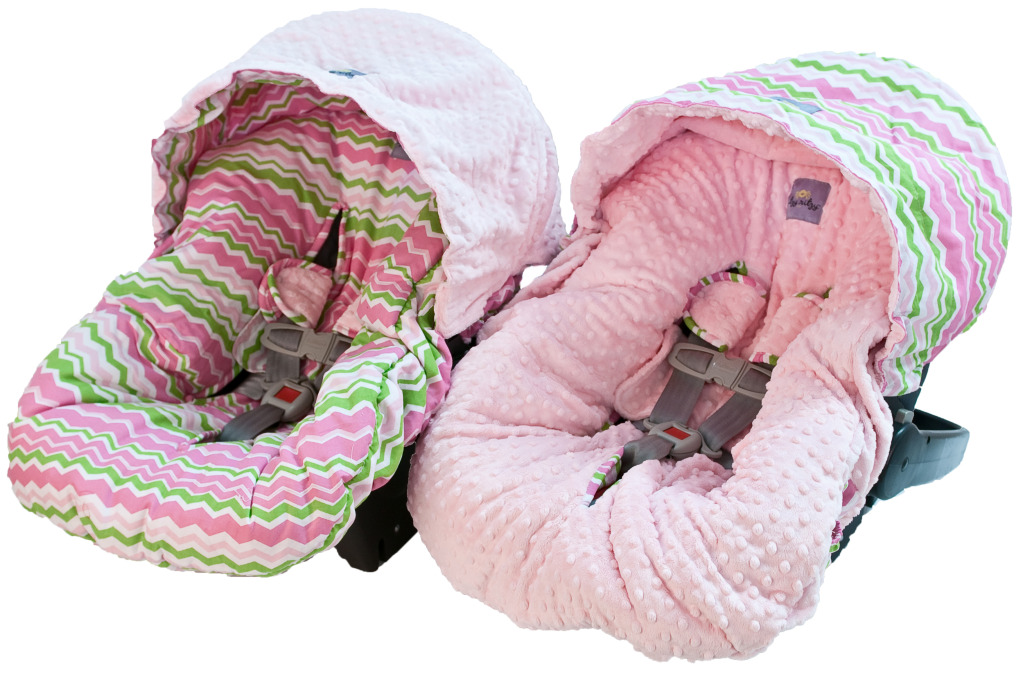Don't Make These 5 Mistakes with Baby's Carseat
Posted by Namely Newborns on Jan 1st 2015
Your baby's carseat is the most important piece of baby equipment that you need to buy. It is a most for safety and convenience. You will use your carseat practically everyday until the child is at least 5 years old and then you will probably graduate into a booster seat. Just because a carseat needs to be sturdy and safe, doesn't mean it can't also be beautiful. At Namely Newborns we have a wide assortment of infant carseat covers and toddler carseat covers as well as replacement covers that will make sure your baby's carseat is comfortable and beautiful. Your child's first car seat is designed to face the rear of the vehicle, and for good reason. In a crash, the back of an infant seat absorbs most of the impact and evenly distributes the remaining force across a baby's back -- his strongest body part. It also cradles his heavy head and relatively weak neck, protecting him from neck and spinal-cord injuries.
Your child's first car seat is designed to face the rear of the vehicle, and for good reason. In a crash, the back of an infant seat absorbs most of the impact and evenly distributes the remaining force across a baby's back -- his strongest body part. It also cradles his heavy head and relatively weak neck, protecting him from neck and spinal-cord injuries.
Another key feature of an infant seat is the adjustable base. It lets you position your baby at a safe angle (about 45 degrees). "If the seat is too upright, your child's head could flop forward in a crash, potentially cutting off his airway," says Lorrie Walker, training manager and technical advisor at Safe Kids Worldwide, in Washington, D.C.
Although experts used to say that a baby was ready for a forward-facing seat after he'd turned 1 and weighed 20 pounds, research has found that children between ages 1 and 2 are five times less likely to be seriously injured in a crash if they're rear-facing. That's why the American Academy of Pediatrics now recommends that all kids ride in a rear-facing seat until they reach the maximum height or weight limit set by the manufacturer. This applies to babies in infant seats as well as to infants and toddlers in convertible seats, which can be used both rear-facing and forward-facing. FIVE MISTAKES TO AVOID
1. Placing your baby in the front seat. The force generated by a deployed front airbag can severely injure or kill a child. Buckle her into the safest spot in your car: the center of the rear seat. A recent study conducted at The Children's Hospital of Philadelphia found that kids seated there were 43 percent less likely to be injured in a crash than those who rode in the side seats. However, any position in the rear is safer than in the front.
2. Using the wrong anchors. The LATCH (Lower Anchors and Tethers for Children) system allows you to attach the seat to metal rings in some cars' rear seats without using the seat belt. But not all cars have anchors in the middle. To install your car seat in the center, make sure you're not using the anchors for a window seat by mistake. If yours doesn't have center anchors, use the seat belt instead.
3. Not getting a tight-enough fit. The seat shouldn't be able to move more than an inch from side to side. When tightening the LATCH straps or seat belt, put your knee in the car seat and push down to help you pull them as tight as possible. You should adjust the harness straps so that you can't pinch a fold in the fabric. "If your child can move forward at all, there is a risk that he could whip forward during a crash and injure his head or spinal cord," says Dr. Durbin.
4. Positioning the harness straps too high. When your baby is rear-facing, adjust the straps so they're threaded through the slots at or below his shoulder level, says Jennifer Stockburger, vehicle and child-safety program manager at Consumer Reports' Auto Test Center, in East Haddam, Connecticut. Otherwise, she could be injured or ejected in a crash.
5. Adding padding. You can't tighten straps snugly if you cover them with cushy pads, wrap your baby in a blanket or a thick coat, or use seat pads that aren't designed for the seat.
